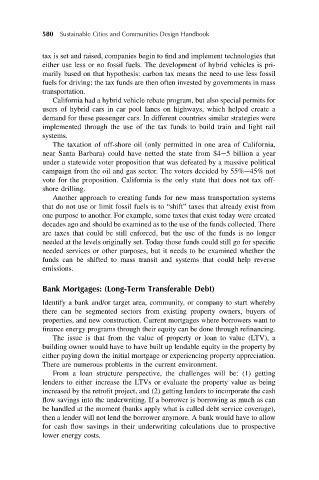Page 613 - Sustainable Cities and Communities Design Handbook
P. 613
580 Sustainable Cities and Communities Design Handbook
tax is set and raised, companies begin to find and implement technologies that
either use less or no fossil fuels. The development of hybrid vehicles is pri-
marily based on that hypothesis: carbon tax means the need to use less fossil
fuels for driving; the tax funds are then often invested by governments in mass
transportation.
California had a hybrid vehicle rebate program, but also special permits for
users of hybrid cars in car pool lanes on highways, which helped create a
demand for these passenger cars. In different countries similar strategies were
implemented through the use of the tax funds to build train and light rail
systems.
The taxation of off-shore oil (only permitted in one area of California,
near Santa Barbara) could have netted the state from $4e5 billion a year
under a statewide voter proposition that was defeated by a massive political
campaign from the oil and gas sector. The voters decided by 55%e45% not
vote for the proposition. California is the only state that does not tax off-
shore drilling.
Another approach to creating funds for new mass transportation systems
that do not use or limit fossil fuels is to “shift” taxes that already exist from
one purpose to another. For example, some taxes that exist today were created
decades ago and should be examined as to the use of the funds collected. There
are taxes that could be still enforced, but the use of the funds is no longer
needed at the levels originally set. Today those funds could still go for specific
needed services or other purposes, but it needs to be examined whether the
funds can be shifted to mass transit and systems that could help reverse
emissions.
Bank Mortgages: (Long-Term Transferable Debt)
Identify a bank and/or target area, community, or company to start whereby
there can be segmented sectors from existing property owners, buyers of
properties, and new construction. Current mortgages where borrowers want to
finance energy programs through their equity can be done through refinancing.
The issue is that from the value of property or loan to value (LTV), a
building owner would have to have built up lendable equity in the property by
either paying down the initial mortgage or experiencing property appreciation.
There are numerous problems in the current environment.
From a loan structure perspective, the challenges will be: (1) getting
lenders to either increase the LTVs or evaluate the property value as being
increased by the retrofit project, and (2) getting lenders to incorporate the cash
flow savings into the underwriting. If a borrower is borrowing as much as can
be handled at the moment (banks apply what is called debt service coverage),
then a lender will not lend the borrower anymore. A bank would have to allow
for cash flow savings in their underwriting calculations due to prospective
lower energy costs.

